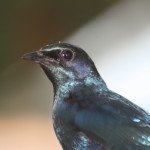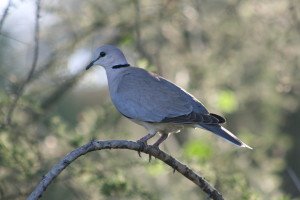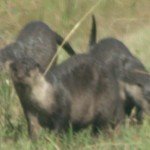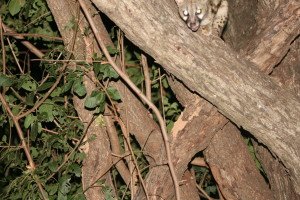Mapungubwe National Park 0
Mapungubwe National Park is renowned for its hostile rocky terrain and hardy baobabs, but at 6.25pm on January 25, the sun is setting and casting its rays over a tropical wetland, reflecting off the water and illuminating the drowned Fever Trees in a magical light.
Through this idyllic setting, two small waterfowl come cruising towards the Maloutswa Pan Hide, easing their way through the vegetation on the water’s surface.
Soon the distinctive small white faces, chestnut breasts and dark green upperparts of the Pygmy Goose became clear – a Lifer and just as I had imagined seeing the most beautiful and exotic of our ducks, and a rather scarce tropical visitor at that.
The illustrations of them in the bird guides have always enthralled me with their beautiful colours, and in real life the Pygmy Goose is even cuter with their bright yellow beaks, drifting serenely through the water lilies.
Maloutswa Pan is a superb spot for birding and typical birds seen are Giant and Pied kingfishers, Threebanded Plover, African Pied Wagtail, Blackwinged Stilt, Diederik Cuckoo, Swainson’s Francolin, Whitefaced Duck, Redbilled Buffalo Weaver, Greenbacked Heron, Egyptian Goose, Wood Sandpiper, African Jacana, Sacred Ibis and Blacksmith Plover.
Numerous other species come and go and on this occasion, a Lanner Falcon was flying along the pan and Abdim’s Stork also flew past, while African Mourning Dove were in one of the dead trees. A male was approaching a female all bowing and cooing and currowling … only for the female to simply fly off! Ah, the perils of courtship.
A large herd of Elephant were making their daily late-afternoon trek from Maloutswa towards the Limpopo River, while a Greybacked Camaroptera was chirping away in an Umbrella Thorn at the hide. The Hadeda Ibis which had loudly announced my arrival had begun to settle down.
Mapungubwe NP is divided into eastern and western sections and Maloutswa is in the western portion, on the Limpopo River floodplain. There is another interesting body of water in the eastern section, a little dam close to the park’s main entrance, and there, along with a Common Sandpiper, was a Common Moorhen.
At first I thought it was a family of Common Moorhen because there were smaller ones with it … Closer inspection, however, revealed a mostly yellow bill, rather than red, and I had a second Lifer, the Lesser Moorhen! Again, it was a fantastic sighting, with the Common Moorhen alongside for comparison.
The brilliant waterbirding in this otherwise dry, hostile environment doesn’t stop there. Between the western and eastern portions of the park lie the Den Staat Wetlands, situated on a private farm but apparently now open to people staying in the park.
The large retention dams with varying levels of water are packed with birds and my late afternoon visit provided African Spoonbill, Ruff, Marsh Sandpiper, African Darter and Fulvous Duck on the water, while the rank vegetation around the dams had Yellowcrowned Bishop just chizzling away, Bluecheeked Bee-Eater, a prowling Burchell’s Coucal, Blackshouldered Kite and Steppe Buzzard.
My visit to Mapungubwe coincided with the place going to seed. But in a good way as the grass had grown to over a metre high in some places, higher than the 4×4’s bonnet and laden with seed.
It soon became apparent that there were quails in there but, as they would fly out for one or two seconds and then disappear into the grass again, identifying them was a near-impossible task. Even in short grass, I would mark the spot where one landed, walk there and find nothing! My best guess, based on the white spots on dark brown I saw when I had a brief glance, was Harlequin Quail.
The frustration of the quails notwithstanding, driving through the Acacia woodland with its lush understorey was extremely rewarding. Wattled Starling were busy and conspicuous, as a Kori Bustard marched sternly through the veld. Less obvious were the Lesser Masked Weaver unobtrusively working its way through the canopy of trees and a Eurasian Golden Oriole silently moving through the same area.
A Booted Eagle came flying out of the woodland, with its distinctive chevron on a dark rump, while Redbilled Helmetshrike, European Cuckoo, Melba Finch, Southern Pied Babbler and Purple Roller were also delightful sightings. A Rattling Cisticola was high up on top of one of the Acacias.
The more open country also held some large flocks of Redbilled Quelea, such a common bird but the breeding males are still so beautiful with their bright pink facial wash and black mask. White Stork and Tawny Eagle were soaring overhead and Whitecrowned Shrike, Common Scimitarbill, Namaqua Dove and Longtailed Starling were also present.
As the sun was setting, a pair of African Hawk Eagle were sitting on a fence (used to keep Elephant out of a regenerating area of woodland), with one descending into the grass next to a big herd of Impala. Ground Hornbill were nearby too.
The Mapungubwe campsite is in the western section and one of the best I have ever had the pleasure of staying in. Mazhou is situated in the dense riverine forest of the Limpopo floodplain and birding is excellent, while various animals also pass through at close quarters.
A pair of Woodland Kingfisher were nesting in a tree at my particular site, with a pair of Crested Barbet in the same tree, in a hole higher up. But they were flying to and from an adjacent tree, so perhaps they had two nests in close proximity, or maybe their trips to the other tree were to divert attention away from their nest?
The delightful White Helmetshrike were visitors to my campsite, one of them struggling to swallow a large caterpillar, while a female Whitebellied Sunbird easily dispatched a spider it caught high in the canopy. A Bearded Woodpecker was also chattering away and easily seen from my chair as was a European Marsh Warbler on my final morning.
When night had just fallen, a Barred Owl flew into a tree above my ‘lounge’; then I heard a ‘chit chit chit’ and the adorable Lesser Bushbaby passed through, leaping acrobatically from tree-to-tree.
From camp it is a short drive to the Limpopo River banks and its huge riverine trees, with Grey Hornbill, Yellowbellied Bulbul and Speckled Mousebird all enjoying the fruiting figs. A Yellowbilled Stork and Bateleur were soaring overhead, while a Nile Monitor pretended to be a log on the side of the road.
Soon the distinctive calls of the African Fish Eagle were heard from overhead, the archetypal riverine raptor also soaring as the temperature reached 36°, the sort of heat that encouraged a Steenbok to go lie under a bush.
For real heat, however, exploring the eastern section, hot, dry and rugged Baobab country with jagged sandstone buttresses, will get you sweating.
Klipspringer, standing motionless like statues, adorn the weathered rocks, while it was so hot (39°) that a Giraffe was lying down under a Baobab chewing on his lunch with his buddy the Blue Wildebeest. It was a very peaceful scene until a biting fly seemingly jabbed the Wildebeest, leading to a typically comical reaction as the Gnu went tearing off in the direction of Zimbabwe.
The Giraffe and the Wildebeest were a slightly odd couple, but there were more regular pairs around like the Black Eagles soaring over a koppie and, at a pan deep in the Mopane in the Kanniedood area, Redheaded Finch amongst a host of queleas. Redbilled Teal were on the water and the surrounding area also held Longtailed Paradise Whydah, Cut-Throat Finch, European Roller and Pale Chanting Goshawk.
Other interesting birds on the “dry” side of Mapungubwe are Monotonous, Sabota and Flappet Larks and Black Kite.
The eastern portion of Mapungubwe also has frontage on to the Limpopo River, with a brilliant treetop boardwalk providing Meyer’s Parrot, given away by its screeching calls before it flew into a tree cavity, meaning it was probably nesting given the time of day. A Marabou Stork was also circling overhead, while beautiful bushveld birds such as the Broadbilled Roller, Brubru, Plumcoloured Starling and Goliath Heron are also present.
Other birds seen in the rich gallery forest were Jacobin Cuckoo, Tropical Boubou and Steelblue Widowfinch.
Even the farm roads around Mapungubwe are great for birding with Chestnutbacked Sparrowlark, Whitebrowed Sparrow Weaver, Amur Falcon and African Cuckoo on the dirt road through the agricultural lands and Pearlbreasted Swallow in amongst the European Swallows and Carmine Bee-Eaters all over the telephone wires. Blackchested Snake Eagle also often uses these perches.
Sightings list
Laughing Dove
Whitecrowned Shrike
Natal Francolin
Longtailed Starling
Woodland Kingfisher
Redbilled Hornbill
Vervet Monkey
Crested Barbet
Redeyed Dove
Tree Squirrel
Whitebacked Vulture
Spotted Flycatcher
Forktailed Drongo
Tawny Eagle
Redbilled Quelea
Whitefronted Bee-Eater
Blue Waxbill
Redbacked Shrike
Southern Greyheaded Sparrow
Common Scimitarbill
Namaqua Dove
Blue Wildebeest
Impala
Waterbuck
Plains Zebra
Redbilled Oxpecker
Warthog
Lilacbreasted Roller
Emeraldspotted Wood Dove
White Helmetshrike
Bushbuck
Whitebellied Sunbird
Cape Turtle Dove
Bearded Woodpecker
European Swallow
Carmine Bee-Eater
Boulenger’s Garter Snake
Chacma Baboon
Southern Masked Weaver
Redbilled Helmetshrike
Crowned Plover
Elephant
Cattle Egret
Rattling Cisticola
Greybacked Camaroptera
Hadeda Ibis
Whitefaced Duck
African Mourning Dove
Redbilled Buffalo Weaver
Greenbacked Heron
Egyptian Goose
Wood Sandpiper
African Jacana
Nile Crocodile
Abdim’s Stork
Sacred Ibis
Blacksmith Plover
African Hawk Eagle
Ground Hornbill
Barred Owl
Jameson’s Firefinch
Whitebrowed Scrub Robin
Jacobin Cuckoo
Grey Hornbill
Yellowbellied Bulbul
Speckled Mousebird
Tropical Boubou
Blackeyed Bulbul
Cardinal Woodpecker
Steelblue Widowfinch
Blackbacked Puffback
Whitewinged Widow
Southern Yellowbilled Hornbill
Yellowbilled Stork
Nile Monitor
Bateleur
Grey Heron
Redbilled Woodhoopoe
Dabchick
Hamerkop
African Fish Eagle
Wattled Starling
Steenbok
Kori Bustard
Slender Mongoose
Longbilled Crombec
Lesser Masked Weaver
Eurasian Golden Oriole
Banded Mongoose
Harlequin Quail
White Stork
Booted Eagle
European Cuckoo
Melba Finch
Purple Roller
Fantailed Cisticola
Lanner Falcon
Giant Kingfisher
Pied Kingfisher
Threebanded Plover
African Pied Wagtail
Blackwinged Stilt
Diederik Cuckoo
Pygmy Goose
Swainson’s Francolin
Lesser Bushbaby
Whitebrowed Sparrow Weaver
Chestnutbacked Sparrowlark
Amur Falcon
Pearlbreasted Swallow
African Cuckoo
Yellowthroated Sparrow
Monotonous Lark
Sabota Lark
Marsh Terrapin
Klipspringer
Cinnamonbreasted Rock Bunting
Rock Dassie
Tawnyflanked Prinia
Broadbilled Roller
Meyer’s Parrot
Southern Black Flycatcher
Brubru
Plumcoloured Starling
Wiretailed Swallow
Goliath Heron
Marabou Stork
Redwinged Starling
Flappet Lark
Giraffe
Black Eagle
Black Kite
Gemsbok
Redheaded Finch
Redbilled Teal
Longtailed Paradise Whydah
Cut-Throat Finch
European Roller
Goldenbreasted Bunting
Pale Chanting Goshawk
Helmeted Guineafowl
Common Moorhen
Lesser Moorhen
Common Sandpiper
Grey Lourie
Blackchested Snake Eagle
African Spoonbill
Ruff
Marsh Sandpiper
African Darter
Fulvous Duck
Yellowcrowned Bishop
Bluecheeked Bee-Eater
Burchell’s Coucal
Blackshouldered Kite
Steppe Buzzard
Southern Pied Babbler
European Marsh Warbler









